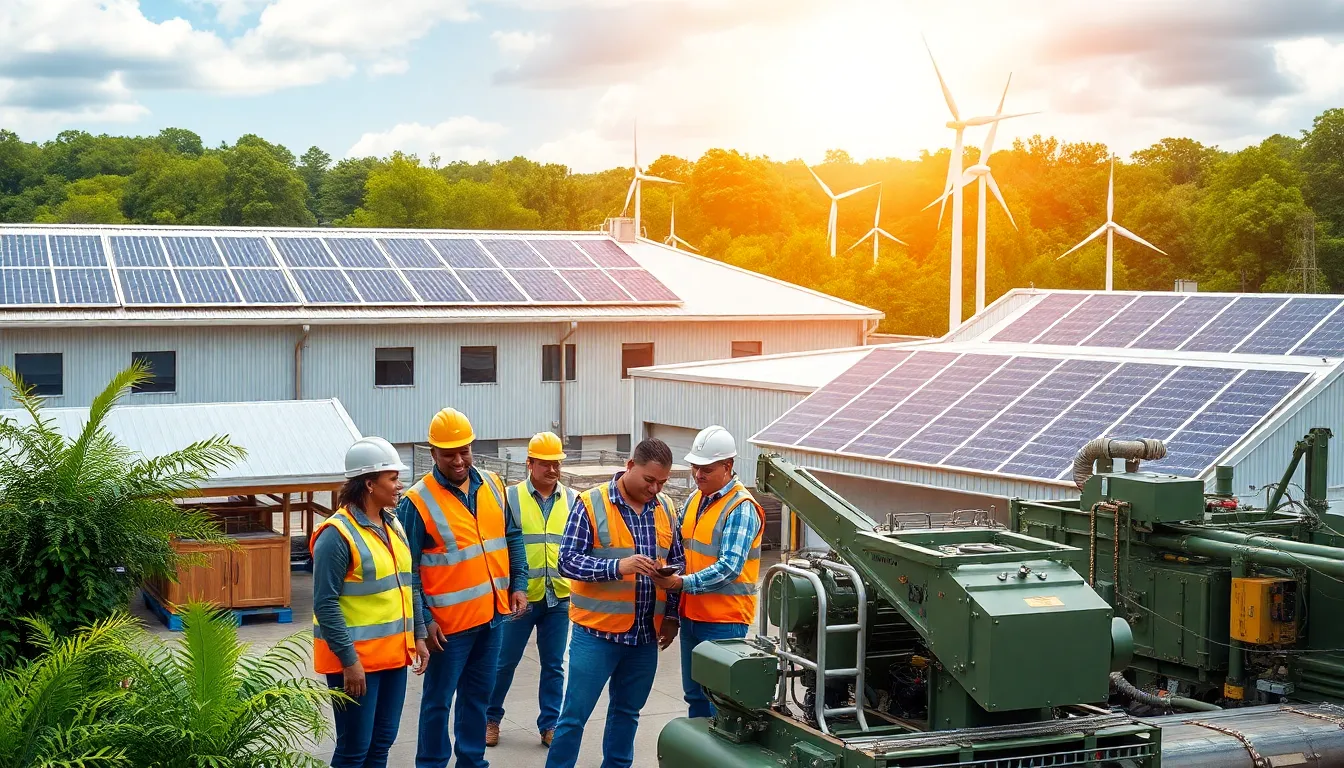In an era where sustainability is paramount, green manufacturing emerges as a vital solution for industries striving to minimize their environmental impact. This innovative approach not only focuses on reducing waste and energy consumption but also aims to create products that are safer for both consumers and the planet. By integrating eco-friendly practices into the manufacturing process, companies can significantly enhance their operational efficiency while appealing to a growing market of environmentally conscious consumers.
As businesses face increasing pressure to adopt sustainable practices, green manufacturing offers a pathway to not only comply with regulations but also to foster a positive brand image. Embracing this paradigm shift can lead to long-term cost savings and a competitive edge in a rapidly evolving marketplace. Understanding the principles and benefits of green manufacturing is essential for any organization looking to thrive in today’s eco-conscious landscape.
Table of Contents
ToggleOverview of Green Manufacturing
Green manufacturing represents a sustainable approach to industrial production, focusing on reducing environmental impact while optimizing resource efficiency. This methodology aligns with contemporary ecological standards and consumer expectations.
Definition and Importance
Green manufacturing involves processes that reduce waste, emissions, and energy consumption during production. This approach is vital for industries as it fosters compliance with environmental regulations and promotes corporate social responsibility. Companies that adopt green manufacturing practices can achieve significant cost savings through enhanced operational efficiency and resource management. Furthermore, this commitment attracts a growing base of environmentally conscious consumers, solidifying market presence.
Key Principles
- Waste Reduction: Implementing practices that minimize waste generation throughout production processes.
- Energy Efficiency: Utilizing energy-efficient technologies and optimizing energy use to reduce overall consumption.
- Sustainable Materials: Sourcing raw materials responsibly from renewable or recycled resources to lessen environmental impact.
- Life Cycle Assessment: Evaluating the environmental impact of products from design to disposal, ensuring a holistic approach to sustainability.
- Continuous Improvement: Encouraging ongoing assessment and enhancement of manufacturing processes to maintain eco-friendly practices.
Benefits of Green Manufacturing

Green manufacturing offers numerous advantages that resonate with both the environment and the economy. By prioritizing sustainable practices, organizations not only contribute positively toward ecological preservation but also realize significant cost efficiencies.
Environmental Impact
Green manufacturing significantly reduces pollution and waste through process optimization. Employing renewable energy sources minimizes greenhouse gas emissions, contributing to improved air quality and reduced climate change effects. Utilizing sustainable materials ensures less harm to ecosystems, promoting biodiversity. Implementing life cycle assessments allows companies to evaluate environmental impacts from production to disposal, facilitating informed decisions that lead to sustainable practices. Overall, adopting green methods fosters a healthier planet for future generations.
Economic Advantages
Green manufacturing presents substantial economic benefits, enhancing operational efficiency and decreasing production costs. Utilizing energy-efficient technologies reduces energy consumption, leading to lower utility bills. Waste reduction strategies decrease disposal costs and improve resource utilization, further optimizing financial performance. Businesses adopting green practices often gain a competitive edge, appealing to environmentally conscious consumers and potentially increasing market share. These advantages collectively contribute to long-term profitability and brand loyalty.
Techniques and Strategies
Green manufacturing employs various techniques and strategies to enhance sustainability and minimize environmental impact. Companies implement these methods to drive operational efficiency and meet evolving market demands.
Sustainable Materials
Sustainable materials play a critical role in green manufacturing. These materials, sourced responsibly, include recycled, biodegradable, or low-impact alternatives that reduce resource depletion. Examples include bamboo, recycled metals, and organic cotton. Implementing life cycle assessments helps companies identify and choose sustainable materials, thereby minimizing adverse environmental effects. Additionally, collaborating with suppliers committed to sustainability can ensure a steady supply of eco-friendly materials, further supporting a company’s green initiatives.
Energy Efficiency
Energy efficiency is essential in reducing the carbon footprint associated with manufacturing processes. Companies adopt energy-efficient technologies such as LED lighting, high-efficiency motors, and smart manufacturing systems to optimize energy consumption. For instance, using renewable energy sources like solar or wind can significantly lower reliance on fossil fuels and decrease greenhouse gas emissions. Implementing process automation and real-time monitoring tools also facilitate energy management, allowing manufacturers to identify and mitigate wasteful practices. Adopting these strategies contributes to long-term cost savings and a smaller environmental impact.
Challenges in Implementation
Implementing green manufacturing poses several challenges that organizations encounter. Addressing these difficulties is crucial for successful adaptation to sustainable practices.
Cost Factors
Cost factors significantly impact the transition to green manufacturing. Initial investments for eco-friendly technologies, such as energy-efficient machinery and renewable energy systems, can be substantial. For instance, companies may spend 10%-30% more on sustainable equipment upfront compared to traditional alternatives. Additionally, sourcing sustainable materials often incurs higher costs, which may deter some organizations. Long-term savings exist but require commitment and financial planning to realize. Despite potential high initial expenditures, companies experience cost reductions in operational efficiency and waste management over time.
Technology Barriers
Technology barriers impede the implementation of green manufacturing practices. Many businesses face difficulties integrating new technologies into existing production processes. For example, retrofitting traditional equipment to accommodate sustainable practices often presents challenges in compatibility and efficiency. A lack of expertise and training further complicates technology adoption. Organizations may struggle to find skilled workers who understand advanced green technologies. Moreover, the rapid evolution of eco-friendly technologies presents challenges in keeping up-to-date with industry advancements, complicating decision-making and strategy development. Embracing these technological hurdles remains essential for enhancing sustainability in manufacturing.
Future Trends in Green Manufacturing
As industries continue to evolve, trends in green manufacturing are paving the way for a more sustainable future. Innovations and regulatory changes are driving these advancements, enabling companies to adapt to new environmental expectations.
Innovations and Developments
Innovations in green manufacturing focus on technological advancements and sustainable practices. Smart manufacturing, powered by the Internet of Things (IoT), enhances efficiency through real-time monitoring and data analytics, enabling manufacturers to minimize waste and optimize resource use. Additive manufacturing, or 3D printing, allows for precise material use, significantly reducing excess waste compared to traditional methods. Bioengineering developments lead to the creation of biodegradable materials, minimizing environmental impact. Further, advancements in renewable energy technologies, such as solar and wind, enable facilities to power operations sustainably. Also, artificial intelligence (AI) plays a crucial role in predictive maintenance and resource management, optimizing processes and reducing downtime.
Regulatory Changes
Regulatory changes impact green manufacturing by enforcing stricter environmental standards. Governments worldwide are introducing regulations aimed at reducing carbon emissions and promoting sustainable practices. Mandates for reporting emissions and waste management drive companies to adopt greener technologies and methods. Additionally, financial incentives, like tax breaks and grants for eco-friendly initiatives, encourage organizations to invest in sustainable practices. The increasing emphasis on circular economy principles also fosters changes in product design and waste management strategies, ensuring products can be reused or recycled efficiently. These regulatory shifts compel industries to not only comply with environmental standards but also actively contribute to a sustainable future.
Green manufacturing stands as a vital strategy for industries aiming to thrive in an eco-conscious world. By focusing on sustainable practices and innovative technologies, companies can significantly reduce their environmental footprint while enhancing operational efficiency. The shift towards eco-friendly production not only aligns with regulatory standards but also resonates with consumers who prioritize sustainability.
Embracing green manufacturing principles fosters a competitive edge, driving long-term profitability and brand loyalty. As businesses navigate challenges related to costs and technology, the commitment to sustainability will ultimately define their success. The future of manufacturing lies in the ability to adapt and innovate, paving the way for a healthier planet and a more sustainable economy.
